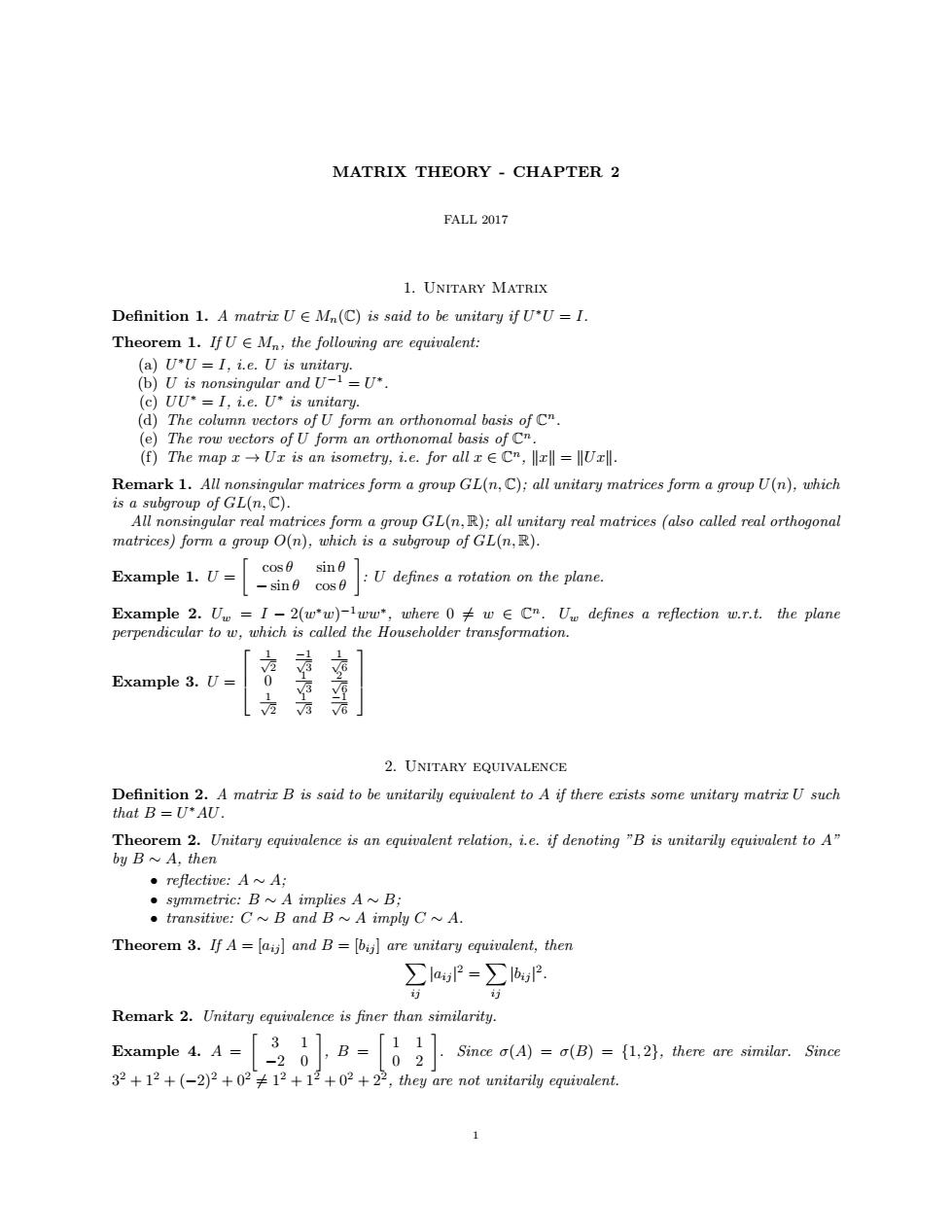正在加载图片...

MATRIX THEORY CHAPTER 2 FALL 2017 1.UNITARY MATRIX Definition 1.A matriz UE Mn(C)is said to be unitary if UU=I. Theorem 1.IfUEM,the following are equivalent. (c)UUU (d)The column vectors of U form an orthonomal basis of C". Remark 1.All nonsingular matrices form a group GL(nC):all unitary matrices form a group U(n).which is a subgroup of GL(n,C). Example 1.U= Uesa nlation on the pne. wEC.V defines a refection w.r.t.the plane Example 3.U= 2.UNITARY EQUIVALENCE iroe tr ent teearr ck Theorem 2.Unitary equivalence is an equivalent relation.ie.if denoting "B is unitarily equivalent to A" bu B~A.then ·refective:A~A: symmetric:B~A implies A~B; .transitive:CB and B~A imply C~A. Theorem 3.If A=and Bare unitary equivalent,then ∑∑1aP=∑bP Remark 2.Unitary equivalence is finer than similarity. Example 4.A 32+12+(2)2+21++02+22,they are not unitarily equivalent. MATRIX THEORY - CHAPTER 2 FALL 2017 1. Unitary Matrix Definition 1. A matrix U ∈ Mn(C) is said to be unitary if U ∗U = I. Theorem 1. If U ∈ Mn, the following are equivalent: (a) U ∗U = I, i.e. U is unitary. (b) U is nonsingular and U −1 = U ∗ . (c) UU∗ = I, i.e. U ∗ is unitary. (d) The column vectors of U form an orthonomal basis of C n. (e) The row vectors of U form an orthonomal basis of C n. (f) The map x → Ux is an isometry, i.e. for all x ∈ C n, kxk = kUxk. Remark 1. All nonsingular matrices form a group GL(n, C); all unitary matrices form a group U(n), which is a subgroup of GL(n, C). All nonsingular real matrices form a group GL(n, R); all unitary real matrices (also called real orthogonal matrices) form a group O(n), which is a subgroup of GL(n, R). Example 1. U = cos θ sin θ − sin θ cos θ : U defines a rotation on the plane. Example 2. Uw = I − 2(w ∗w) −1ww∗ , where 0 6= w ∈ C n. Uw defines a reflection w.r.t. the plane perpendicular to w, which is called the Householder transformation. Example 3. U = √ 1 2 √−1 3 √ 1 6 0 √ 1 3 √ 2 6 √ 1 2 √ 1 3 √−1 6 2. Unitary equivalence Definition 2. A matrix B is said to be unitarily equivalent to A if there exists some unitary matrix U such that B = U ∗AU. Theorem 2. Unitary equivalence is an equivalent relation, i.e. if denoting ”B is unitarily equivalent to A” by B ∼ A, then • reflective: A ∼ A; • symmetric: B ∼ A implies A ∼ B; • transitive: C ∼ B and B ∼ A imply C ∼ A. Theorem 3. If A = [aij ] and B = [bij ] are unitary equivalent, then X ij |aij | 2 = X ij |bij | 2 . Remark 2. Unitary equivalence is finer than similarity. Example 4. A = 3 1 −2 0 , B = 1 1 0 2 . Since σ(A) = σ(B) = {1, 2}, there are similar. Since 3 2 + 12 + (−2)2 + 02 6= 12 + 12 + 02 + 22 , they are not unitarily equivalent. 1